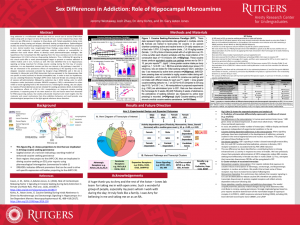Westaway, Jeremy: Sex Differences in Addiction: The Role of Hippocampal Monoamines
Title: Sex Differences in Addiction: The Role of Hippocampal Monoamines
Name: Jeremy Westaway
Major: Psychology
School affiliation: School of Arts and Sciences
Programs: Aresty – RA Program
Other contributors: Amy Kohtz and Josh Zhao
Abstract: Drug addiction is a multifaceted national crisis with an annual cost of around $740 billion dollars along with an impact on tens of thousands of lives. Current research has shown that there are sex differences in response to drug abuse, with female populations being more susceptible to drug craving and relapse, ultimately leading to dependence. Epidemiological studies also show that stress predisposes women to shorter periods of abstinence compared to men. Animal models have recapitulated these findings using rodents. However, it is unclear what molecular and neural pathways underlie resilience or susceptibility to addiction that could inform efforts to develop novel pharmacotherapies strategies. We hypothesize that norepinephrine (NE) signaling from the locus coeruleus (LC) to the dorsal hippocampus CA1 (CA1) enhances drug-seeking behaviors. Thus, inhibiting NE signaling in this circuit could offer a novel pharmacological target to prevent or reverse addiction in rodent models and in turn, humans as well. We have identified this LC to hippocampus signaling as being important for driving cocaine seeking during the first day of cocaine extinction, in a sex dependent manner and thus our interest in this pathway is two-fold: 1. We are interested in the persistence effects of manipulating LC-NE signaling to CA1 using designer receptors exclusively activated by designer drugs (DREADDs) and 2. We are in interested in ribonucleic acid (RNA) transcripts that are expressed in the hippocampus that are specific to male (resilient) or female (susceptible) rats. In order to test our hypotheses, we use a Seeking Persistence Paradigm (SPP) where male and female rats undergo 10 days of cocaine self-administration followed by extinction day 1 (ED1) testing, prior to which clozapine-n-oxide (exclusively activates DREADD receptors; CNO) is administered to either inhibit or excite signaling from LC-NE neurons to CA1. Following ED1 testing, rats are subject to 2 weeks of forced abstinence and are retested for seeking persistence (ED2), to determine the persistence effects of LC-NE to CA1 manipulations on long-term cocaine seeking persistence. A separate group of rats were tested on ED1 and tissues were fresh dissected for RNA-sequencing analysis. Our studies will provide important and novel insights into the molecular and neural mechanisms that drive addiction behaviors and could provide new pharmacological perspectives in the fight against substance abuse disorders.
